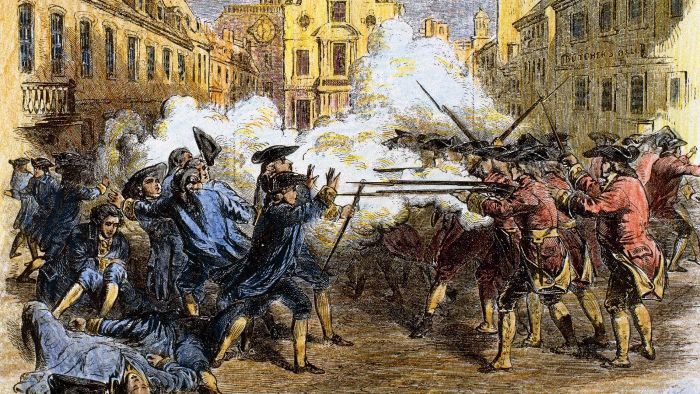The Boston Massacre was a tragic event in American history that paved the way for the American Revolution or America’s quest to become an independent country from Britain. It began when a fight broke out in 1770 in Boston, Massachusetts, that ended with British soldiers killing five American colonists.
Crispus Attucks was the first person killed in the Boston Massacre – and thus became known as the first fatality in the fight for American independence.
As an African-American patriot, Attucks represents the 5,000 African American soldiers who fought for an independent America. His death contributed to the unpopularity of the British regime in North America in the years before the American Revolution.

Before the Revolutionary War or the war of independence, the 13 American colonies were ruled by Britain. This arrangement initially worked out well under the policy of salutary neglect, but then Britain started asking the colonists to pay taxes in order to pay for the imperial debt after the French and Indian War.
The taxes were first on products like sugar and molasses; it later spread to legal documents, newspapers and playing cards. American colonists rebelled against the taxes, saying that it was a violation of their rights to pass taxes on them without direct representation in parliament.
What made matters worse was when the British, in 1767, tried another series of fees on exports, known as the Townshend Duties. This required the colonists to pay money to Britain when they bought items like paper, glass, and tea. The colonists saw this as unfair and repressive and began to rebel against the move.
In Boston, a city that relied on commerce and seagoing trade to survive, rioting, vandalism, and violence targeted at the British became the order of the day. By 1768, British soldiers were sent to Boston to regain control.
This increased tensions as there was now more than 2,000 British soldiers occupying the city of 16,000 colonists and trying to enforce Britain’s tax laws.
That was when Crispus Attucks arrived in the scene.
Not much is known about his early life, however, varying accounts state that his father must have been an enslaved man named Prince Yonger. His mother was said to be Nancy Attucks, a Native Indian.
There is what seems to be evidence that Attucks escaped slavery in 1750. In that same year, the Boston Gazette contained an ad offering 10 pounds to anybody who could find a runaway slave named “Crispas.”
After reportedly escaping slavery, Attucks is believed to have joined whaling ships and worked as a harpooner and a ropemaker. Accounts state that in order to avoid being sent back into slavery, Attucks worked by the name “Michael Johnson.”
When the massacre occurred, Attucks had planned to stay in Massachusetts only for a short period. He had just come back from a voyage to the Bahamas and was getting ready to set sail for North Carolina when a brawl broke out days before the Boston Massacre.
It is reported that on March 2, 1770, a fight erupted between a group of Boston rope makers and three British soldiers. This would become worse three nights later and become known as the Boston Massacre.
The massacre happened following a dispute over a barber bill near the Customs House, the centre of the British government in Boston. On March 5, 1770, a young boy complained that a British officer had failed to pay his barber bill, but the officer denied this.

A British sentry then started harassing the boy, and soon a crowd of colonists that had gathered at the venue began harassing the officer in return.
When a contingent of British guards came to the defence of their colleague soldier, angrier Bostonians started tossing snowballs, pebbles, and wood at the soldiers. Then gunshots rang out. Five colonists died, and Attucks is believed to have been the first to fall.
Some accounts said Attucks was at the Customs House before the incident began. Others said he arrived later with a group of men and attacked the soldiers with a piece of wood.
It has also been documented that he was only watching the scene, leaning on a stick. Nonetheless, Attucks was said to have been at the front of the crowd that night, and he was killed.
Attucks, along with the four other victims—Samuel Maverick, Samuel Gray, James Caldwell, and Patrick Carr—were buried at Boston’s Granary Burying Ground. The funeral procession attracted about 10,000 people.
Meanwhile, any British soldier involved in the incident faced the prospect of hanging, but John Adams, who would later be America’s second president, defended them. He claimed that the soldiers acted in self-defence. Eventually, no one was convicted of murder, and the ruling incensed the public in Boston.
The uproar that followed the massacre also compelled the British troops to temporarily withdraw from the city. The Boston Massacre consequently had a huge impact on relations between Britain and the American colonists.
Colonists, who were already enraged at British rule and the unfair taxation, rose to fight for independence. Beginning with the Boston Tea Party, the colonists formed the First Continental Congress and later launched the American Revolution.
In 1888, more than a century after the Boston Massacre, a massive monument was erected at Boston Common to commemorate Attucks and the four other men who died.
Attucks would later be hailed among abolitionists and civil rights activists, including Dr Martin Luther King Jr., who celebrated him in 1964 for his “moral courage and his defining role in American history”.
Attucks is still honoured by most Americans. In 1998, to commemorate the 275th anniversary of his birth, the U.S. Mint issued a silver dollar coin in honour of Attucks.
Many schools, children centres, foundations and museums are named after him, representing the struggle and heroism of a black man searching for freedom.










